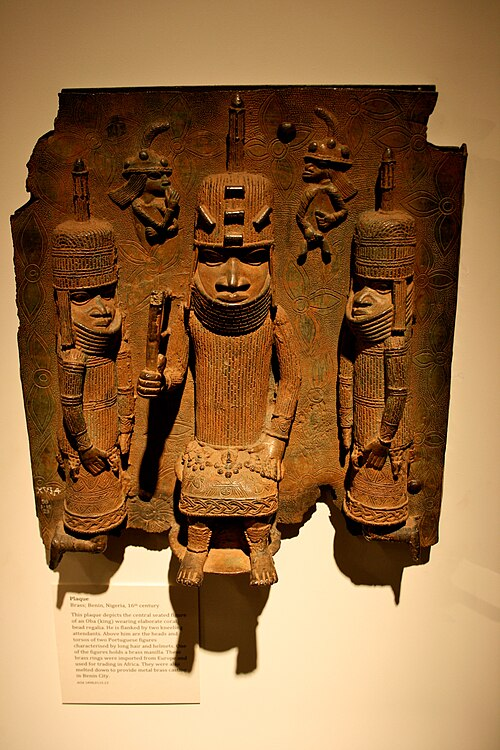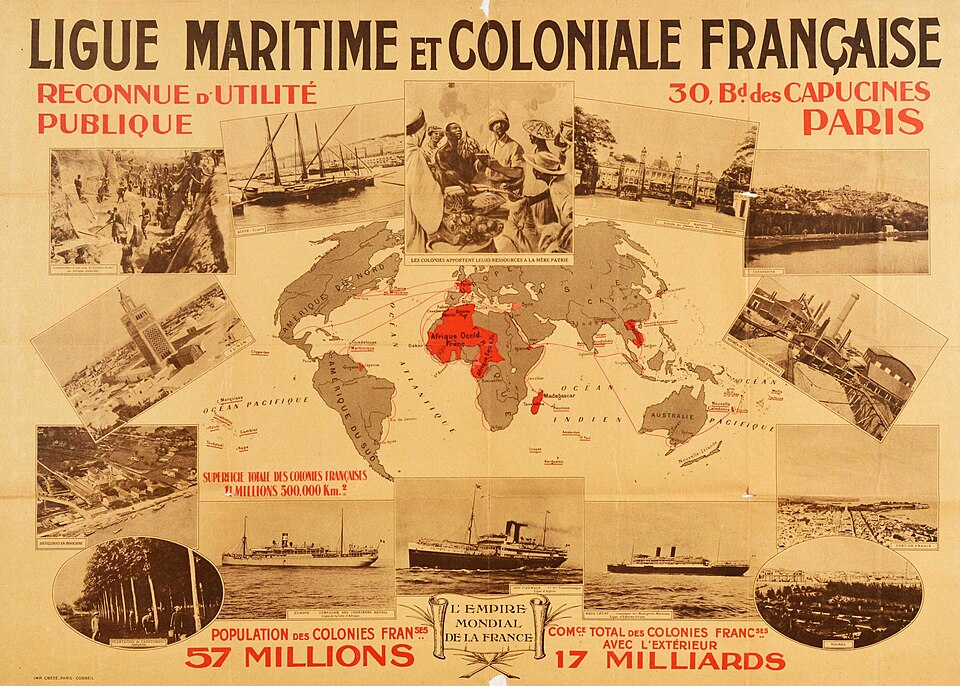IB Syllabus focus:
'Analyze how colonialism influenced and impacted art and culture in Africa, exploring both positive and negative aspects.'
The encounter between European colonial powers and African societies profoundly influenced the development of arts and culture across the continent. These changes were multifaceted, leaving a legacy that is both celebrated for its syncretic creativity and critiqued for its disruptive impacts on traditional practices.
European Influence on African Art
Introduction of Western Artistic Concepts
Adoption of New Techniques: African artists were introduced to oil painting, watercolour, and sculpting in marble and bronze, which contrasted with indigenous methods.
Western Artistic Education: Colonial administrations established art institutions teaching European styles, leading to a generation of artists trained in these techniques. This was similar to the Renaissance in Italy, where new artistic methods and education flourished.
Portraiture and Landscapes: African artists began to produce works for European patrons, often focusing on portraiture, which was not a traditional African art form, and European-style landscapes.
The Shift in Artistic Functions
From Ritual to Commercial: Traditional African art was deeply entwined with social and religious functions, which was often sidelined as art became more commercialised under colonial influence.
Art for External Audiences: Art was increasingly created for European consumers, leading to a departure from indigenous styles that catered to the aesthetic preferences of foreigners.
Transformation of Cultural Practices
Modification of Languages and Literature
Dominance of Colonial Languages: European languages became the lingua franca of education and governance, affecting the development of literature and official discourse in Africa. This is akin to the changes brought about by the spread of Islam and Christianity in Africa.
Development of New Genres: New literary genres were adopted, including the novel, short story, and drama, often reflecting colonial themes.
Evolution in Music and Performing Arts
European Instruments and Scales: The introduction of instruments like the piano and guitar led to new musical forms that were a blend of African and European elements.
Censorship and Control: Colonial authorities often suppressed traditional performances seen as a threat to their control, leading to the decline of some forms of indigenous music and dance.
Positive Aspects of Cultural Exchange
Syncretism and Innovation
Artistic Synthesis: The merging of European and African artistic principles led to innovative art forms, seen in the work of artists like Ben Enwonwu of Nigeria.
Preservation Efforts: European collectors and ethnographers played a role in preserving African art forms, although often this was done within a framework that objectified the cultures they came from.

Benin brass plaques (16th century) on display at the British Museum, London. Their presence in a European museum reflects both the preservation and the colonial displacement of African art; the plaques were widely acquired after the 1897 British punitive expedition to Benin. Source
Enhanced Visibility and Appreciation
International Recognition: African art was exhibited in international expositions and gained recognition, influencing artists worldwide.
Art as Historical Document: Art created during the colonial period now serves as a document of the time, providing insight into the cultural exchanges and tensions, similar to how Mandinka resistance to French rule provides historical context.
Negative Impacts on African Culture
Undermining Indigenous Art Forms
Devaluation of Local Traditions: The imposition of European art standards often led to the devaluing of traditional African art forms and techniques.
Loss of Artisan Skills: As the focus shifted towards European styles, traditional skills and knowledge were lost or went undervalued.
Cultural Displacement and Identity
Identity Crisis: The colonial encounter led to a cultural dissonance as Africans were forced to reconcile their indigenous identities with the imposed European cultural norms. This displacement can be compared to the changes brought by Nigeria's direct and indirect rule.
Marginalisation of Indigenous Languages: The dominance of European languages marginalised African languages, affecting the transmission of oral traditions and cultural expressions.
Colonial Ideology and Artistic Expression
Art as Propaganda
Colonial Narratives: Art was used to propagate the idea of the ‘civilising mission’ and European cultural supremacy.

French colonial propaganda poster (c. 1930) showing a world map with French possessions highlighted and images of infrastructure and “improvement.” It crisply illustrates how visual culture promoted imperial hierarchies and justified domination to metropolitan audiences. Source
Racialised Representations: Artistic depictions often reinforced colonial racial stereotypes and ideologies.
Suppression and Resistance
Censorship: Art that critiqued or challenged colonial rule was often censored or suppressed.
Art as Resistance: In response, African artists sometimes used symbolism and allegory to express resistance and critique the colonial order.
Post-Colonial Artistic Movements
Artistic Revival and Cultural Reassertion
Cultural Revival: After independence, there was a concerted effort to revive traditional arts and cultural practices, often as a means of nation-building. These efforts can be seen as part of broader strategic causes of partition in Africa.
Contemporary Art Movements: Modern African artists draw on both the colonial experience and indigenous traditions to inform their work.
Performing Arts as Cultural Commentary
Revolutionised Theatre: Post-colonial theatre often focuses on issues of identity, power, and the legacies of colonialism.
Film as a Narrative Tool: African filmmakers utilise the medium to tell African stories from African perspectives, subverting colonial narratives.
Colonialism and the Performing Arts
Theatrical Adaptations and Developments
Introduction of Western Theatrical Forms: European plays and operas were introduced, leading to new forms of African theatre that blended these influences with local storytelling traditions.
Impact on Dance: Traditional dances were adapted to fit European tastes or hybridised with European dance forms, sometimes leading to entirely new dance traditions.
Cinema and Film
Colonial Cinema: Initially, cinema in Africa served colonial propaganda, portraying Europeans as saviours and Africans as needing guidance.
Post-Colonial Cinema: With independence, cinema became a key medium for reclaiming African stories, with filmmakers like Ousmane Sembène leading the way.
Impact on Education and Artistic Training
Establishment and Role of Art Schools
Formal Art Education: Colonial powers established art schools which often marginalised indigenous art forms in favour of Western techniques.
Curriculum Changes: Post-independence, curricula began to change to incorporate and emphasise African artistic traditions.
Conclusion
The colonial impact on African art and culture was profound and ambivalent, characterized by both loss and innovation. It was a period of significant upheaval that led to the emergence of new forms and the transformation of traditional practices. For IB History students, understanding this dynamic interplay is essential to grasping the complexities of African colonial and post-colonial history. This understanding is further enhanced by studying other historical contexts, such as the Renaissance in Italy.
FAQ
The colonial era transformed the traditional patronage system of African art, shifting it from local and community-based support to a market driven by European demand. Pre-colonial African art was often commissioned by rulers, religious leaders, and community members and served specific communal or ritual purposes. Under colonial rule, the market for African art became commodified, with European collectors and colonial officials becoming the main patrons. This shift undermined the economic foundations of traditional art practices, as the new system favoured art that appealed to European tastes and standards, often neglecting the artists' cultural and social context.
Colonialism introduced new materials and techniques to African artistry, which significantly altered traditional practices. The availability of European paints, canvases, and tools allowed African artists to experiment with new forms of artistic expression, such as oil painting and watercolour. Additionally, the introduction of photography provided a new medium through which to capture and express cultural realities. However, the influx of these new materials sometimes led to the decline of indigenous techniques and mediums, such as natural dyes, clay, and plant fibres, as they were either undervalued or replaced by imported alternatives.
Colonialism profoundly affected the narrative structure and content of African storytelling and oral traditions. The introduction of European literary forms and languages pressured African storytellers to adapt their narratives to fit new structures, such as the novel and play, often at the expense of traditional oral and communal storytelling practices. Content-wise, stories began to reflect the experiences and challenges of colonial rule, including themes of displacement, cultural conflict, and identity crisis. Moreover, the preference for written over oral literature marginalised the oral custodians of history, altering the transmission and evolution of indigenous stories and historical narratives.
Colonial exhibitions and world fairs played a pivotal role in shaping Western perceptions of African art and culture. They often presented African art and artefacts within contexts that reinforced colonial ideologies, depicting African societies as primitive and in need of Western intervention. These exhibitions exoticised African cultural expressions, creating a narrative where African art was appreciated for its 'primitive' aesthetic rather than its cultural significance. However, they also inadvertently raised the profile of African art on the global stage, leading to increased interest and appreciation among Western artists and audiences, albeit often through a paternalistic lens.
Colonialism significantly influenced the subject matter of African art, steering it towards themes and motifs that resonated with the colonial narrative. Artisans were often commissioned to produce works that glorified the colonial enterprise, depicting Africans in subordinate roles or exoticising African cultures. Scenes of daily life, landscapes, and portraiture were tailored to European tastes or used to reinforce stereotypes. This shift meant traditional themes that reflected communal values, spirituality, and indigenous lore received less emphasis, as the colonial market demanded art that affirmed their world view and aesthetic preferences.
Practice Questions
The colonial period saw a significant transformation in African visual arts, primarily marked by the introduction of European artistic forms and techniques. This included the adoption of oil painting and sculpture, which were not indigenous to African artistic traditions. However, the impact of colonialism was not wholly negative; it also resulted in the emergence of new, syncretic forms of art, as African artists began to blend traditional techniques with those introduced by Europeans. An excellent example of this is the work of Nigerian artist Ben Enwonwu, who fused European techniques with African motifs. The extent of colonial impact, therefore, was considerable as it resulted in both the disruption of traditional arts and the creation of new forms that continue to influence African art today.
Colonialism profoundly altered the representation of African identity in literature and performing arts by imposing European cultural standards and narratives. African literature adopted new forms, like the novel and drama, often incorporating colonial languages and themes. In performing arts, colonialism introduced Western theatrical forms and controlled the content of performances, frequently censoring traditional expressions. Post-colonial works, however, reclaimed African narratives, as seen in the rise of theatre that tackled issues of colonial oppression and identity. The alteration was thus twofold; initially, colonialism diluted African identity through European lenses, but it eventually catalysed a resurgence of African-centric expressions that assert indigenous identities and experiences.

